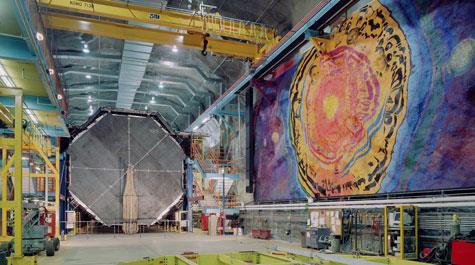The sterile neutrino is running out of places to hide — if it even exists, that is
William & Mary physicist Mike Kordosky is a skeptic on the sterile-neutrino question, but he says he would be happy to be proven wrong.
He was instrumental in the design of an experiment that was intended to prove the existence of sterile neutrinos, theoretical subatomic particles that are believed to be responsible for actions of other kinds of neutrinos. Recently released results of the experiment — actually, a pair of experiments conducted a world apart — have vindicated Kordosky’s skepticism. For now.
A press release from the Fermi National Accelerator Laboratory announced a recent search for the sterile neutrino has come up empty. Kordosky said that null result from the collaboration between his MINOS experiment at Fermilab and the Daya Bay experiment in China doesn’t slam the door on the sterile neutrino concept, but it does make the particle’s existence a lot less likely.
Neutrinos have bizarre properties. They exist in three (at least) types, or “flavors.” They change, or oscillate, from one flavor to another in mid-flight. And they almost never interact with matter, a property that makes neutrinos devilishly hard to study.
The sterile neutrino — if it indeed exists — is an oddball even among neutrinos. The three known neutrino flavors, tau muon and electron, interact with matter only rarely. The sterile neutrino never interacts with matter directly, only indirectly, through gravity.
The sterile neutrino was offered as a potential answer to a puzzle that arose 20 years ago. Scientists at Los Alamos National Lab found evidence of a new, unexpected, neutrino oscillation at their LSND experiment beginning in the 1990s. The sterile neutrino was posited as an explanation, and the search was on to find that particle.
Duck hunters stake out likely lakes and rivers; particle hunters look for their prey within likely levels of energy. Kordosky says the sterile neutrino search focused on the energy region around 1 electronvolt squared.
“This was a region where a couple of other experiments had seen anomalous results. It’s a region that we can’t completely rule out — but now we’re close,” he said.
“I never thought those anomalous results looked like sterile oscillations,” he added.
The MINOS detector is used for “normal” neutrino oscillation experiments. Kordosky explained that MINOS sends a beam of muon neutrinos through a pair of detectors, one near the beam source in Chicago and the second some 450 miles away in Minnesota.
To search for the sterile neutrino, Kordosky and his colleagues had to figure out a way to use MINOS detector for something it really wasn’t designed to do. A standard MINOS experiment would count the number of oscillated neutrinos between the near and far detectors, “with the assumption that no oscillations have occurred before the beam reaches the near detector,” he said.
“Here’s the problem: For this sterile neutrino search, the initial assumption that oscillations haven’t occurred isn’t valid,” Kordosky explained. “So you have to find a way to use the far detector to constrain the near detector. You look for sterile oscillations as a modulation on top of the standard oscillations. The method that we used was to take the ratio between the two detectors. That cancels out a lot of uncertainties.”
Kordosky is an associate professor in the Department of Physics, one of a number of William & Mary scientists in that are participating in neutrino investigations. In fact, William & Mary has a number of physicists on both sides of the MINOS-Daya Bay collaboration. In addition to Kordosky, the William & Mary MINOS authors on the sterile neutrino paper are Jeffrey Nelson, professor of physics; Patricia Vahle, associate professor of physics; Alena Devan Ph.D ’15; and Alexander Radovic, a postdoctoral research associates. William & Mary scientists on the Daya Bay side were Robert McKeown, Governor's Distinguished CEBAF Professor of Physics; and Wei Wang, research scientist.
In fact, Kordosky says some of the initial conversations that led to the MINOS-Daya Bay collaborations occurred at William & Mary. His office is adjacent to the office used by Wei Wang and Kordosky said the two of them would discuss how Daya Bay and MINOS could collaborate.
In contrast with MINOS, which uses a neutrino beam generated at Fermilab, the Daya Bay experiment looks at electron antineutrinos coming from a nuclear power plant in China.
Daya Bay measured for the first time one of the parameters governing neutrino oscillations, a result garnering the 2016 Breakthrough Prize in Fundamental Physics, an honor which included Robert McKeown, who is deputy director for science at Jefferson Lab in addition to his faculty position at William & Mary. A sterile neutrino would affect the rate at which electron antineutrinos disappear, but the Daya Bay scientists have seen no evidence for this.
“Neither the MINOS nor Daya Bay disappearance results alone can be compared to the LSND appearance measurements,” En-Chuan Huang in the Fermilab press release. Huang, of Los Alamos Laboratory and the University of Illinois at Urbana-Champaign, is one of the scientists working on the Daya Bay experiment. “Looking at multiple types of neutrinos together gives us a much stronger handle on sterile neutrinos.”
The Fermilab release says the joint null result “has significantly shrunk the hiding space for a light sterile neutrino,” while noting that scientists will continue to look for the sterile neutrino.
Kordosky says he’s happy to participate in the continuing hunt for the sterile neutrino, even if he is a skeptic, believing the LSND anomalies have another explanation.
“It could be poorly understood neutrino reactions,” he said. “It could be one of these things that happen in science: an anomalous result that gets excluded by other experiments.”
Even though a skeptic, he says he would be happy to see evidence of a sterile neutrino.
“It would be new physics,” he said, “a revision of the Standard Model. It’s what we’re all working toward.”















